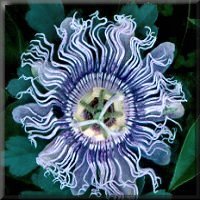
Passiflora incarnata

Passiflora incarnata
Origin: North America, Europe, South America
Part of the plant used: Dried ariel parts, gathered during fruiting season
Description: Passion flower is a woody vine with flowers which reminded early Jesuit travelers of the passion or suffering of Christ. The plant produces a small berry-like fruit called granadilla or water lemon. Passiflora incarnata, the plant we use to induce sleep, is one of the northern-most growing of the passion vines. Whereas most of them are indigenous to tropical America, the "maypop," as it is known, ranges as far north as Virginia. All of the members of the passion vine family contain chemicals with relaxing properties to a greater or lesser degree, and the maypop is the best in the lot for an overactive mind when it comes time to fall asleep. The colonials learned of its soothing properties upon their arrival in the New World, and from there, ultimately is became a feature in the doctor's medicine cabinet.
Pharmacology: Passion flower contains glycosides (containing alkaloids) and flavonoids. Low levels of serotonin have been identified which may help explain the use of passion flower as a natural calmative, mood shifter, and aid to concentration. Another compound called "maltol" has been shown to have mild sedative properties. The harmane alkaloids have been shown to be spasmolytic toward smooth muscle and to lower blood pressure by expanding heart coronary vessels.
Active Properties: For the past 200 years, passion flower has been used to tranquilize and settle edgy nerves. Passion flower induces sleep without causing confusion upon awakening. Passion flower has been used by women to calm nerves and induce relaxation during the periods of hormonal adjustment found during menes, partition and menopause.
Toxicity, Cautions & Contraindications No known toxicity
Use standardized whole plant extracts
Historical Uses: